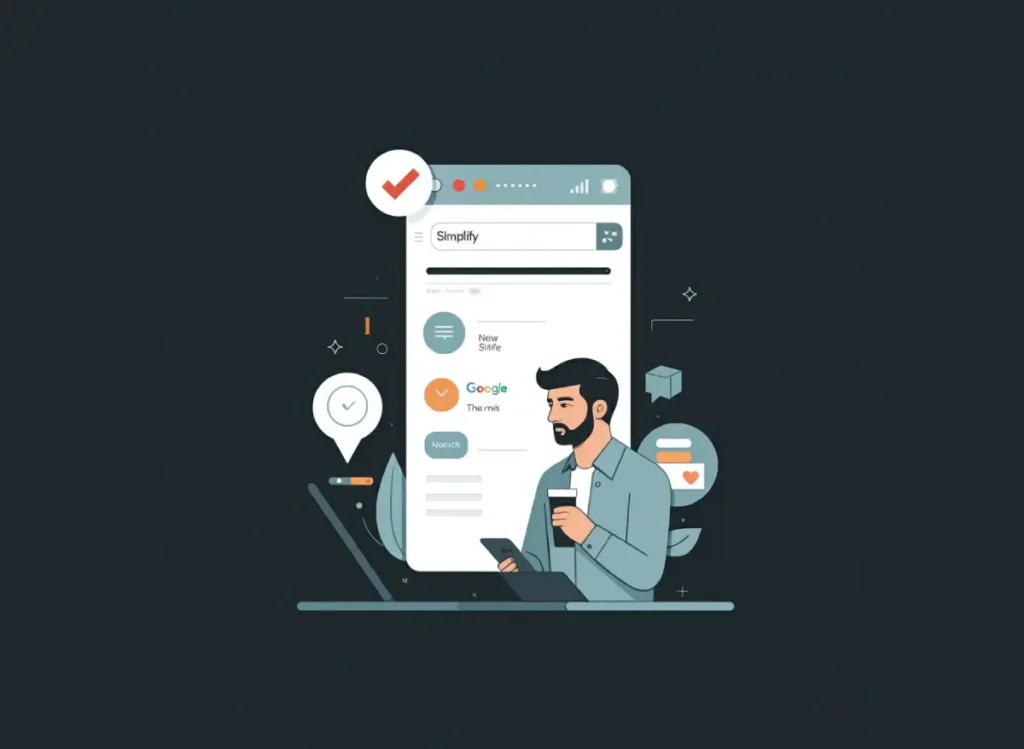Master User Search Intent: Boost SEO & Conversions
Have you ever felt like you’re shouting into the void with your content?
Trust me, I’ve been there.
When I first started Inkbot Design, my branding and design agency, I thought I had it all figured out.
Killer designs ✅
Snazzy website ✅
Clever copy ✅
But the traffic? Crickets. 🦗
Then, I discovered the secret sauce: user search intent.
It was like putting on glasses for the first time. Suddenly, everything came into focus.
I’m not exaggerating when I say it transformed my business. And today, I will show you how to do the same.
🔰 TL;DR: Mastering user search intent is crucial for SEO success. This guide covers the four main types of search intent, how to identify them, and strategies to optimise your content accordingly. You’ll learn to read between the lines of search queries, create content that truly resonates with your audience, and skyrocket your organic traffic. Buckle up—it’s time to become a search-intent Jedi! 🚀
- Mastering user search intent significantly enhances SEO success and boosts conversion rates for your business.
- Understanding the four main types of search intent—informational, navigational, commercial, and transactional—is essential for optimising content.
- Aligning content with search intent not only improves traffic but also enhances user experience and increases engagement rates.
What is User Search Intent? 🤔

User search intent is the ‘why’ behind a search query. A user’s goal is to type (or speak) something into a search engine and get the result that solves their search query.
Think of it as the digital equivalent of mind reading. Instead of crystal balls, we use data and user behaviour analysis.
The Four Horsemen of Search Intent
There are four main types of search intent:
- Informational 📚
- Navigational 🧭
- Commercial 💼
- Transactional 💳
Let’s break these down, shall we?
1. Informational Intent: The Knowledge Seekers 📚
Informational queries are all about learning. Users with this intent seek answers, explanations, or general information.
Examples:
- “What is branding?”
- “How to design a logo.”
- Benefits of responsive web design
How to Optimise for Informational Intent:
- Create comprehensive, in-depth content
- Use clear headings and subheadings
- Include visuals, infographics, and videos
- Answer related questions (think: “People Also Ask” boxes)
Pro Tip: Don’t just regurgitate facts. Add your unique insights and experiences. When I write about branding, I often include real-world examples from Inkbot Design projects. It adds credibility and keeps readers engaged.
2. Navigational Intent: The Destination Seekers 🧭
These users know precisely where they want to go. They’re using search as a shortcut to reach a specific website or page.
Examples:
- “Facebook login”
- Inkbot Design portfolio
- “BBC News homepage”
How to Optimise for Navigational Intent:
- Ensure your brand name is prominent in titles and meta descriptions
- Create clear sitelinks
- Optimise your Google My Business listing (for local searches)
Anecdote Time: I once had a client who insisted on optimising their competitor’s brand name. Spoiler alert: it didn’t work. Focus on owning your brand terms instead.
3. Commercial Intent: The Researchers 💼
Users with commercial intent are in research mode. They’re considering a purchase but want to compare options or learn more before committing.
Examples:
- Best logo design services
- Branding agency vs freelancer
- Website redesign cost
How to Optimise for Commercial Intent:
- Create comparison guides and reviews
- Highlight unique selling points
- Use customer testimonials and case studies
- Create ‘vs’ content (e.g., “Inkbot Design vs Competitors”)
Real Talk: This is where many businesses drop the ball. They focus so much on the hard sell that they forget to educate. Don’t make that mistake. Be the helpful expert, not the pushy salesperson.
4. Transactional Intent: The Buyers 💳
These users are ready to take action. They want to purchase, sign up for a service, or complete a specific task.
Examples:
- Buy custom logo design.
- “Hire branding agency”
- Book web design consultation
How to Optimise for Transactional Intent:
- Use clear call-to-action buttons
- Streamline your checkout or contact process
- Highlight special offers or guarantees
- Use urgency and scarcity tactics (ethically, of course)
Personal Insight: At Inkbot Design, we saw a 30% increase in conversions when we optimised our service pages for transactional intent. It’s not just about being found—it’s about being discovered by the right people at the right time.
The Search Intent Spectrum: It’s Not Always Black and White 🌈

Here’s where it gets interesting. Search intent isn’t always clear-cut. Many queries fall somewhere on a spectrum.
For example, “logo design ideas” could be:
- Informational (for someone learning about design)
- Commercial (for someone considering hiring a designer)
- Even transactional (for someone ready to buy a logo template)
The key is to create content that caters to multiple intents where possible.
How to Identify Search Intent: Becoming a Digital Detective 🕵️♂️
- Analyse the Query:
- Look for intent-signalling words:
- Informational: “how”, “what”, “why”
- Navigational: brand names, website names
- Commercial: “best”, “top”, “vs”, “review”
- Transactional: “buy”, “discount”, “deal”
- Look for intent-signalling words:
- Check the SERPs:
- Google’s algorithm is pretty good at understanding intent
- Look at what type of content is ranking
- Use Tools:
- Keyword research tools often categorise intent
- SEMrush and Ahrefs are great for this
- Consider the Buyer’s Journey:
- Awareness stage → Informational
- Consideration stage → Commercial
- Decision stage → Transactional
The SEO Goldmine: Aligning Content with Search Intent 💰

Here’s where the rubber meets the road. Aligning your content with search intent is like giving Google a big, flashing sign saying, “Pick me! Pick me!”
1. Audit Your Existing Content
- Is it meeting the right intent?
- Can you repurpose or update it?
2. Create Intent-Specific Content
- Informational → Blog posts, guides, FAQs
- Commercial → Comparison pages, case studies
- Transactional → Product pages, landing pages
3. Optimise On-Page Elements
- Title tags
- Meta descriptions
- Headers
- URL structure
4. Use Schema Markup
- Help search engines understand your content better
5. Monitor and Adjust
- Search intent can change over time
- Keep an eye on your rankings and traffic
The Power of Search Intent: Beyond SEO 🚀
Understanding search intent isn’t just about pleasing Google. It’s about creating a better user experience.
When you nail search intent:
- Bounce rates decrease
- Time on page increases
- Conversion rates soar
- Customer satisfaction skyrockets
It’s a win-win-win situation. Users find what they need, Google serves relevant results, and you get more traffic and conversions.
Common Pitfalls: Don’t Fall Into These Traps! ⚠️
- Keyword Stuffing: Just because a keyword has a high volume doesn’t mean it’s suitable for your content.
- Ignoring User Experience: Don’t sacrifice readability for SEO.
- Neglecting Mobile Users: Mobile search often has a different intent. Optimise accordingly.
- Forgetting About Featured Snippets: These are gold for informational queries.
- Overlooking Voice Search: “OK Google” has changed the game. Are you ready?
The Future of Search Intent: What’s Next? 🔮

As AI and machine learning advance, search engines better understand nuanced intent.
We’re moving towards:
- More conversational search
- Increased personalisation
- A better understanding of the context
To stay ahead, focus on:
- Creating comprehensive, authoritative content
- Understanding your audience deeply
- Embracing new technologies (voice search, AI writing assistants)
Putting It All Together: Your Action Plan 📝
- Audit Your Current Content:
- Identify gaps in intent coverage
- Update existing content to match intent better
- Develop an Intent-Focused Content Strategy:
- Map out content for each stage of the buyer’s journey
- Create a diverse content mix
- Optimise for Intent:
- Update title tags, meta descriptions, and headers
- Restructure content if necessary
- Monitor and Iterate:
- Track rankings, traffic, and conversions
- Be ready to adapt as intent shifts
- Stay Informed:
- Keep up with SEO news and algorithm updates
- Continuously educate yourself on user behaviour
The Inkbot Design Approach: A Case Study 🎨
At Inkbot Design, we’ve seen firsthand the power of aligning with search intent.
When we revamped our content strategy:
- Organic traffic increased by 150%
- Lead quality improved dramatically
- Conversion rates jumped by 40%
How? Creating content that truly resonates with our audience at every stage of their journey.
We’ve covered everything from informational blog posts about branding basics to in-depth case studies for those considering our services.
Conclusion: The Search Intent Revolution 🌟
Mastering user search intent is like having a superpower in the digital world.
It’s not just about rankings or traffic. It’s about truly understanding and serving your audience.
When you get it right, magic happens. Your content resonates, your audience engages, and your business grows.
So, are you ready to join the search intent revolution?
Remember, at Inkbot Design, we’re not just talking the talk. We’re walking the walk. And we’re here to help you do the same.
Want to see how we can transform your digital presence with intent-focused design and content? Let’s chat. Your audience is searching. Make sure they find you.
FAQs: Everything Else You Need to Know 🤓
How often does search intent change?
It can change seasonally or with current events. Regular monitoring is critical.
Can one piece of content target multiple intents?
Yes, but creating separate pieces for each intent is often more effective.
How does voice search affect search intent?
Voice queries are more conversational and often have informational intent.
Is search intent the same across all industries?
The basic types are universal, but how they manifest can vary by industry.
How do I measure if I’m meeting search intent?
Look at metrics like bounce rate, time on page, and conversion rate.
Can I use AI to determine search intent?
AI tools can help, but human insight is still crucial for nuanced understanding.
How does search intent relate to keyword difficulty?
Transactional keywords often have higher difficulty due to competition.
Should I create separate content for mobile and desktop users?
Not necessarily, but ensure your content is mobile-optimised and considers mobile user intent.
How does search intent affect PPC campaigns?
Matching ad copy and landing pages to intent can significantly improve click-through and conversion rates.
Can search intent help with content ideation?
Absolutely! Understanding intent can uncover content gaps and new opportunities.
How does search intent relate to E-E-A-T (Experience, Expertise, Authoritativeness, Trustworthiness)?
Meeting the right intent helps demonstrate E-E-A-T by showing you understand and can fulfil user needs.
Is it worth optimising for informational queries if I’m an e-commerce site?
Yes! Informational content can build trust and guide users towards transactional pages.

